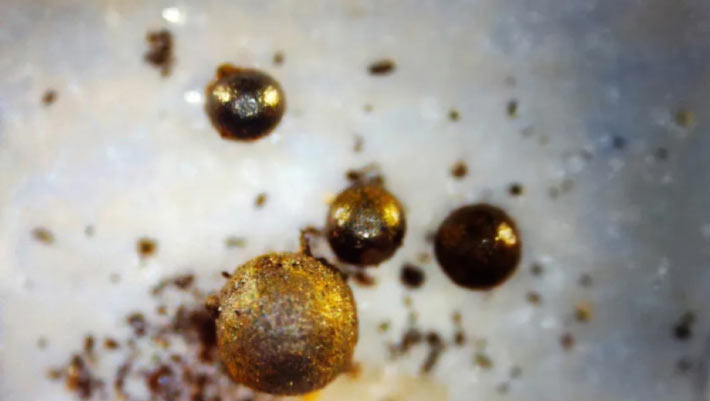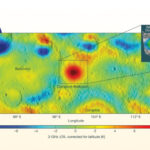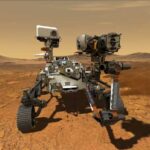Harvard University’s Professor Avi Loeb and colleagues have discovered at least 50 tiny spherical iron fragments near the fireball path of the first recognized interstellar meteor, IM1.
Tiny meteoritic spherules from the most likely path of IM1. Image credit: Avi Loeb, Harvard University / Galileo Project.
IM1 was detected over the South Pacific, off the northern coast of Papua New Guinea, in 2014.
Also referred to as CNEOS 20140108, the meteor had an estimated mass of 460 kg and was between 80 cm and 1 m (2.6-3.3 feet) in diameter.
The object was identified as an interstellar meteor candidate in 2019, and confirmed in 2022.
“IM1’s fireball was detected by the U.S. Government at 17:05 GMT on January 8, 2014 and indicated that this meteor was speeding beyond the value required to escape from the Solar System,” said Professor Loeb, the leader of the Galileo Project, which aims to identify the nature of potential objects made by existing or extinct extraterrestrial technological civilizations.
“Based on the air ram-pressure that it sustained before disintegrating in three flares 20 km above the ocean surface, this object was tougher in material strength than all other 272 meteors in the CNEOS catalog of NASA.”
“Its interstellar origin was formally confirmed at the 99.999% confidence in an official letter from the U.S. Space Command under DoD to NASA on March 1, 2022.”
“Two years earlier, my discovery paper of IM1 with my undergraduate student Amir Siraj showed that IM1 was moving outside the Solar System faster than 95% of all stars in the vicinity of the Sun.”
“The possibility that IM1’s excess speed benefited from propulsion and the fact that it was tougher than all known space rocks, raise the possibility that it may have been technological in origin — similar to NASA’s New Horizons craft colliding with an exoplanet in a billion years and burning up in its atmosphere as an interstellar meteor.”
As part of the Galileo Project, Professor Loeb and his team aimed to retrieve the meteoritic spherules of IM1.
On 14 June, 2023, they set out for the meteor’s estimated landing zone in the South Pacific Ocean.
“It took us a few days on board the aluminum ship, which is fittingly called Silver Star, to get the magnetic sled on the ocean floor and a few more days to understand what we collected,” Professor Loeb explained.
“As we scooped the magnets, the most abundant material attached to them was a black powder of volcanic ash.”
“It was everywhere, including the control regions far from IM1’s site.”
“I was frustrated by this background to the extent where I titled one of my diary reports: Where are the spherules of IM1?”
“And then came the breakthrough,” he said.
“After a week at sea we used a filter with a mesh size of a third of a millimeter to sift through the tiny volcanic particles and examine the remaining larger particles under a microscope.”
“Shortly thereafter, the team’s geologist Jeff Wynn came running down the stairs to tell me that the team’s analyst Ryan Weed saw through the microscope a beautiful metallic marble of sub-millimeter size and sub-milligram mass.”
“I rushed up to the top level of our ship. When Ryan showed me the image, I asked him to place this spherule in the X-ray fluorescence analyzer. He responded: ‘Sure, we can do it later.’ I hugged him, thrilled by the finding, and said: ‘Please do it right now’.”
“The composition analysis implied 84% iron, 8% silicon, 4% magnesium and 2% titanium, plus trace elements.”
“I knew immediately that we would find many more spherules. When you find a single ant after surveying a small part of the kitchen, you know that there are many more ants out there. Sure enough, we found more spherules within a few hours.”
The team was able to collect more than 50 spherical fragments from IM1’s landing site.
“These sub-millimeter-sized spheres, which appear under a microscope as beautiful metallic marbles, were concentrated along the expected path of IM1 — about 85 kilometers off the coast of Manus Island in Papua New Guinea,” Professor Loeb said.
“Their discovery opens a new frontier in astronomy, where what lay outside the Solar System is studied through a microscope rather than a telescope.”
“That 83% of the matter in the Universe is apparently composed of dark matter which was not found yet in the solar system should teach us modesty in forecasting the nature of interstellar objects.”
Just a few days ago, the researchers examined several spherules using an electron scanning microscope and an elemental analyzer.
“By now, we studied five spherules with a scanning electron microscope and laser ablation mass spectroscopy,” Professor Loeb said.
“The composition of the spherules along the meteor path is consistently from the same source, whereas the background spherules from the control region had a different morphology and composition.”
“The meteor composition is consistent with the results from the X-ray fluorescence analyzer on the ship.”
“Interestingly, the meteor spherules show evidence for a rapid heating event with surface dendrites whose spatial separation can be used to estimate the highest temperature they reached in the fireball.”
“We also noticed an inner structure of spheres within spheres, implying hierarchical merger events of droplets during the explosion.”
“But most interestingly, the mass spectroscopy revealed uranium and lead,” he said.
“The isotope uranium-238 decays to lead-206 with a half-life of 4.47 billion years and uranium-235 decays to lead-207 with a half-life of 0.71 billion year. This allows us to estimate the age of the spherules in two independent ways.”
“Based on the measured abundance of uranium-238, lead-206, uranium-235 and lead-207, I calculated that the two spherules from the meteor path have an age of order the age of the Universe (13.8 billion years) whereas the background spherule has an age of order the age of the Solar System (4.6 billion years).”
“In the coming weeks we will examine further any clue for the spherules being different from solar system materials.”
“This will constitute independent evidence for the interstellar origin of IM1 in addition to its measured speed.”
“The expedition demonstrates how science should be done,” he concluded.
“Driven by raw curiosity and wonder, on a topic of great interest to the public, while seeking evidence to find the truth and finding it despite all odds after a heroic effort by a team of dedicated professionals.”




